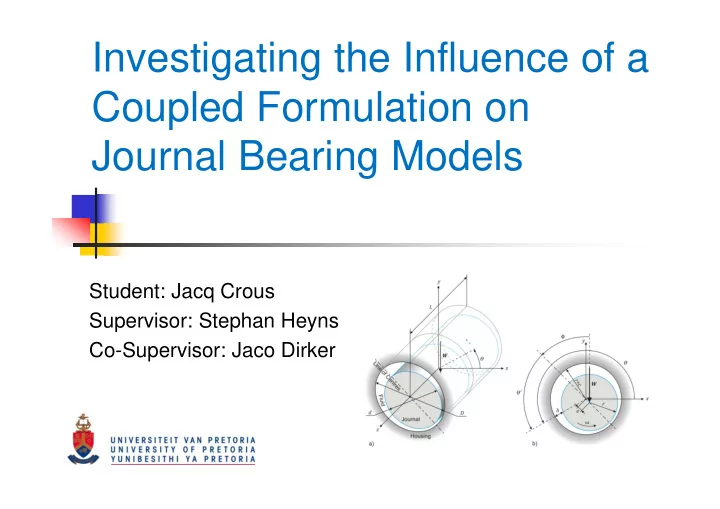

Investigating the Influence of a Coupled Formulation on Journal Bearing Models Student: Jacq Crous Supervisor: Stephan Heyns Co-Supervisor: Jaco Dirker
Context of Study – Rotor-Bearing-Seal System: This study was concerned with the bearing models. 2
3 Context of Study – Bearing:
Context of Study: Condition Effective Realistic based analysis of the models monitoring available data In order to monitor the condition of steam turbines in real time we need to use the available information more effectively. This requires the development of a complete, realistic model of the rotor-bearing system. Armand Kruger is working on the rotor model and my study was concerned with the bearing models. 4
5 Mineral Oil Polymer additives Solvent: The Issue: Multi-Grade Oil
Fluid Models: Viscoelastic Formulation Viscous Formulation Fluid motion is modelled by the Cauchy Fluid behaviour modelled by a equation of motion (neglecting body generalized Navier-Stokes Formulation: forces): � ��̅ �� � �̅ ∙ � �̅ � ��̅ �� � �̅ ∙ � �̅ � ��� � � ∙ �̿ � ��� � � ∙ � ��̅ � � � � �̅ � - Density of the fluid. �̅ - Velocity field. � - Density of the fluid. � - Pressure field. �̅ - Velocity field. � � - Extra-stress tensor. � - Pressure field. 6
Heat Transfer: The first law of thermodynamics in differential form, for incompressible fluids, is used to model the heat transfer: �� �� � �� � �̅ ∙ � � � � �: ��̅ � � ∙ ��� � � - heat capacity of fluid. k - Thermal conductivity of the fluid. � � - Cauchy stress tensor 7
Numerical Solvers: OpenFOAM was used to develop the numerical solvers. OpenFOAM is a C++ library that provides various interpolation schemes as well as algebraic solvers. OpenFOAM solves PDEs and can give tensor, vector and scalar fields as outputs. 8
Coupling of Fluid Formulations: Viscoelastic Formulation Viscous Formulation Velocity Field Velocity Field Viscosity Temperature Dependencies Field Viscosity Temperature Polymer Dependencies Field Stress Field 9
Solvers Developed: Viscoelastic Viscous Formulation Formulation Viscous Giesekus Fluid Fluid Stokes Oldroyd-B Fluid Flow 10
Driving Forces for the Flow: Rotating Journal Shearing of Oil Simulation of a full scale journal bearing would require 5 � 10 � control volumes! 11
Alternative Approach A section of the bearing is extracted form the converging section of the bearing. The extracted section has the same driving forces in the same measure as the corresponding point in the bearing. Oil Journal 12 Converging section
Weak Coupling - Viscous Formulation: Difference between formulations Velocity Profiles 0.12 1 0.1 0.8 0.08 0.6 R/C ∆ 0.06 0.4 0.04 0.2 0.02 0 0 0 20 40 60 80 0 0.2 0.4 0.6 0.8 1 V [m/s] R/c Coupled Stokes Formulation Coupled Stokes Formulation Coupled Viscous Formulation Coupled Viscous Formulation Uncoupled Viscous Formulation Classical Formulation Uncoupled Viscous Formulation 13
Weak Coupling – Viscoelastic Formulation: Difference between Velocity Profiles formulations 1 0.06 0.05 0.8 0.04 0.6 R/c ∆ 0.03 0.4 0.02 0.2 0.01 0 0 0 20 40 60 80 100 0 0.2 0.4 0.6 0.8 1 1.2 V [m/s] R/c Coupled Giesekus Coupled Oldroyd-B Classic Formulation Coupled Oldroyd-B Coupled Giesekus 14
Strong Coupling – Viscous Formulation: Difference between Velocity Profiles formulations 1.2 1.6 1.4 1 1.2 0.8 1 ∆ 0.8 R/c 0.6 0.6 0.4 0.4 0.2 0.2 0 0 0 0.2 0.4 0.6 0.8 1 1.2 0 50 100 150 200 R/c V [m/s] Coupled Stokes Formulation Coupled Stokes Formulation Coupled Viscous Formulation Coupled Viscous Formulation Uncoupled Viscous 15 Uncoupled viscous formulation Classical Formulation formulation
Strong Coupling – Viscoelastic Formulation: Difference between Velocity Profiles formulations 1.2 0.7 0.6 1 0.5 0.8 0.4 0.6 0.3 0.4 0.2 0.2 0.1 0 0 0 20 40 60 80 100 120 0 0.2 0.4 0.6 0.8 1 1.2 Strong Coupled Formulation (Giesekus) Strong Coupled Formulation (Giesekus) Weaker Coupled Formulations (Oldroyd-B) Weaker Coupled Formulation (Oldroyd-B) 16
Conclusion: The coupling, whether weak or strong, was seen to significantly affect the fluid behaviour. The Strong coupling was seen, in particular, to change the nature of the flow behaviour by departing form the classical formulation in a non-homogeneous way. A coupled formulation is vitally important to accurately model large scale journal bearings! 17
Questions? 18
Recommend
More recommend